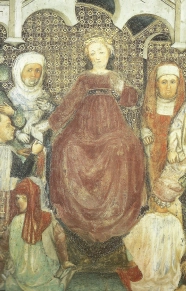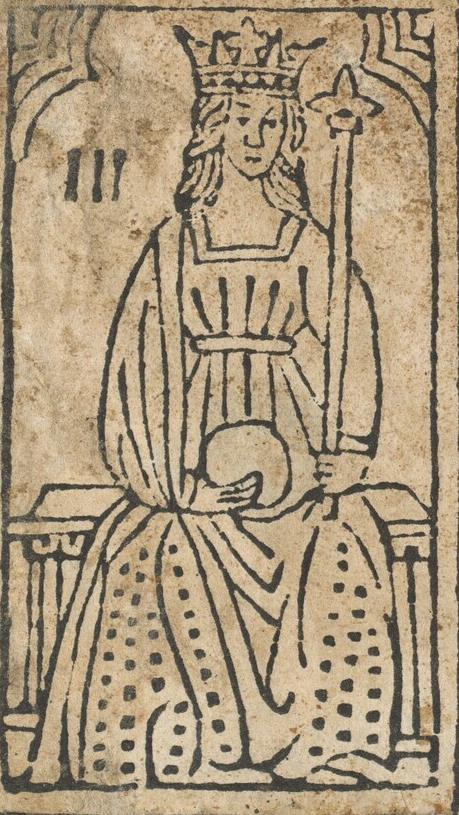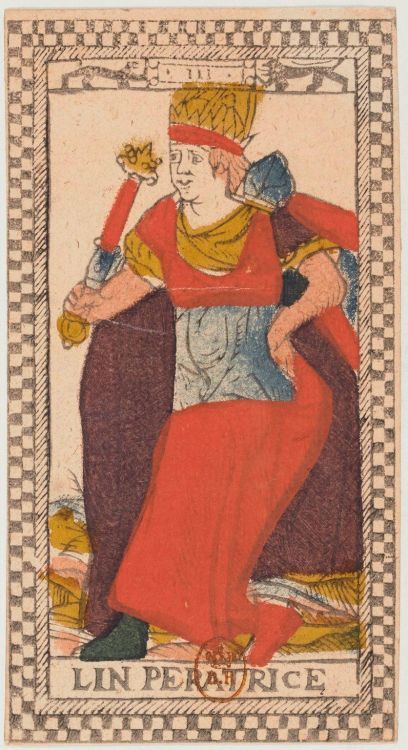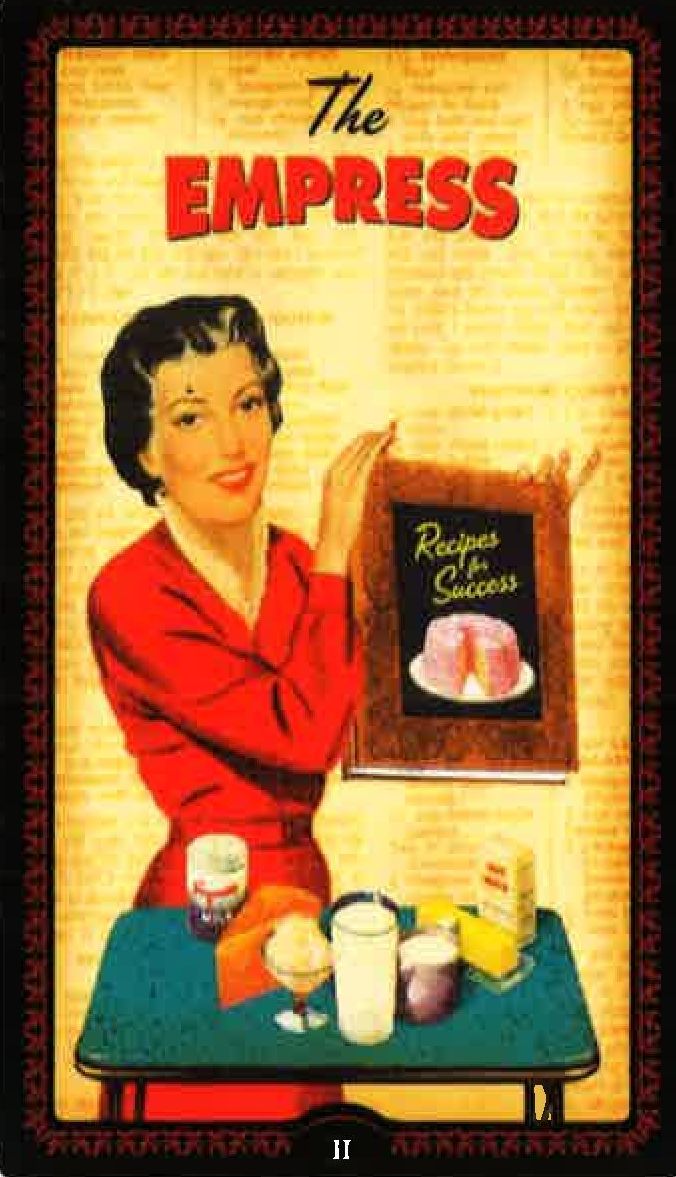

To understand the original iconography of the Empress, it must be placed in the context of women of power from the late Middle Ages and the Renaissance. Contrary to common beliefs, many women then exercised real political power, either by inheritance or as regents of their absent husbands.
Barbara von Celje (1392-1451), wife of Emperor Sigismund, administered his lands in Hungary and served as imperial regent during her husband's frequent absences. Queen of Hungary and Bohemia in her own right, she perfectly embodied this figure of the Empress holding autonomous power. The rumors about her private life and religious beliefs testify to the difficulties encountered by these powerful women in a patriarchal world.
Similarly, Queen Theodolinda of the Lombards (around 570-628), immortalized in the frescoes of Monza Cathedral by the Zavattari brothers around 1440, shows a striking resemblance to the first Empresses of the Tarot. These women presided over their own courts, controlled vast territories and, once their dynastic duty was accomplished through the birth of heirs, often enjoyed considerable freedom.
The Allegory of Power was traditionally represented in the features of a woman enthroned with imperial insignia, as evidenced by the engraving of Antonio Albizzi (1610). This classical iconography explains why the first master craftsmen naturally chose a female figure to embody supreme temporal authority, long before the Empress became a symbol of motherhood.
Saint Radegund, born in 518, was a Thuringian princess who became Queen of the Franks by marrying Clotaire I, son of Clovis. Her exceptional journey perfectly illustrates the complexity of female power in the Merovingian era: first a war hostage, then queen consort, she finally voluntarily renounced her royal status to found the Holy Cross Abbey of Poitiers. This trajectory from temporal to spiritual power prefigures the symbolic evolution of the Tarot Empress.
In the political context of the time, Radegund represented a unique model of autonomous female sovereignty. Unlike traditional queen consorts, she exercised direct political influence and had her own possessions. Her decision to leave the royal court to lead a pious and charitable life was not a renunciation of power, but its transformation: from power over men to power over souls, from temporal authority to spiritual authority.
Radegund is often represented as a nun, sometimes with a crown placed near her, symbolizing this duality between abandoned power and acquired spiritual power. This iconography of "power laid down but not lost" will be found in certain representations of the Empress, notably in versions where she holds her coat of arms rather than wearing it.
By making a correlation between Saint Radegund and the Empress of the Marseille Tarot, we can see similarities in their representation of transformative feminine power. While Radegund chose to use her power for the spiritual good of others, the Empress represents the creative power that transforms spirit into matter. Both figures embody a form of generative rather than dominating feminine power, whether through charity and devotion or through creation and cosmic motherhood.
The evolution of the Empress reveals a major conceptual transformation in the history of Tarot: the gradual passage from a representation of concrete political power towards a universal archetype of the feminine creative principle. This mutation operates in several distinct historical stages, each marked by the concerns of its era.
First phase (15th-16th centuries): The political Empress. In the first tarots, she literally embodies imperial authority, with all its attributes: crown, scepter, orb and heraldic eagle. This representation corresponds to an era when the Holy Roman Empire still structures Europe and when women of power exercise real political authority.
Second phase (17th-18th centuries): Marseille codification. With the Marseille Tarot, the Empress keeps her imperial attributes but begins to develop more maternal and protective aspects. The coat of arms held in her arms rather than placed on the ground already suggests a more intimate, more nurturing relationship to power.
Third phase (19th century): Esotericization. French occultists, notably Éliphas Lévi, transform the Empress into a cosmic figure: she becomes the "Woman of the Apocalypse" crowned with stars, incarnation of the universal creative principle. This mutation marks the definitive passage from political to spiritual.
Fourth phase (20th-21st centuries): Archetypal motherhood. The modern Empress definitively abandons her imperial attributes to become the universal Mother, symbol of fertility, natural abundance and artistic creativity. This evolution reflects the social transformations of the feminine condition and the rediscovery of the "sacred feminine".
The contemporary interpretation of the Empress must take into account the radical transformations of family and motherhood models since the 1960s. The card can no longer be content to represent the traditional mother at home, but must integrate the diversity of modern feminine experiences: single mothers, blended families, late motherhood, medically assisted reproduction, international adoption.
The modern Empress embodies a chosen rather than endured motherhood, creative rather than reproductive. She represents the woman who consciously decides to give life, whether biologically, artistically or spiritually. This evolution reflects the gradual conquest of feminine reproductive autonomy and the redefinition of motherhood as a personal project rather than as a social destiny.
In the context of new family models, the Empress also symbolizes the nurturing function beyond biological bonds: benevolent stepmother, adoptive mother, feminine mentor, or even a man assuming a maternal role. Her archetype transcends gender to embody the psychological function of protective and nurturing "container".
The sociological evolution of the Empress also testifies to the emergence of new values: sustainable development (she becomes an ecological goddess), collaborative economy (she inspires mutual aid networks), feminine entrepreneurship (she embodies the business creator). These mutations make her a particularly relevant archetype for understanding contemporary aspirations to reconcile personal fulfillment, social responsibility and creativity.
The philosophy of the Empress rests on a fundamental distinction between two modalities of power: dominating power (traditional masculine) and generative power (archetypal feminine). Unlike the Emperor who imposes his will through force and authority, the Empress exercises a creative power that brings forth novelty through gestation, maturation and birth.
This major philosophical difference opposes creation to procreation. Procreation reproduces the existing according to determined biological patterns, while creation brings forth the radically new. The modern Empress embodies this pure creativity: she does not content herself with reproducing life, she invents new forms of existence, whether artistic, intellectual or spiritual.
The archetype of the Empress also questions the notion of "sacred feminine" rediscovered by contemporary spiritual movements. This concept goes beyond the simple valorization of biological motherhood to explore the cosmic dimensions of the feminine principle: creative receptivity, intuitive wisdom, connection to natural cycles, capacity for alchemical transformation.
In a Jungian perspective, the Empress represents the positive anima, this feminine dimension of the psyche that enables creativity, empathy and connection to the sensible world. She embodies the reconciliation between nature and culture, instinct and consciousness, individuality and universality. This synthesis makes her a particularly relevant archetype for contemporary quests for authenticity and integral fulfillment of personality.
Only the master craftsman of the Paris tarot allows himself a variation by representing the Empress standing (just like the Emperor). It is mainly about representing the character, in a classical way, as was done in antiquity. Although here, the empress walks and places her hand casually on her hip (as does the prince of the Chariot). One would think she is participating in a fashion show! But let us not be mistaken, she is indeed parading! This differs from the Emperor card of this same tarot, also standing, but very static. Here, was the engraver's intention to attribute qualities of impulsiveness or even seduction to the character?
With Jean Noblet, for the first time, the Empress is shown with a shield, which is an original and specific representation. The same year, Viéville shows a very similar empress. The question of a tarot, common ancestor of Jean Noblet and Jacques Viéville, having been published between 1615 and 1650 is perfectly legitimate! We will probably never know if Jean Noblet was the inventor of the tarot that would become the famous "Marseille Tarot".
The Empress of the Marseille Tarot with her coat of arms that she carries in her arm, is more associated with the mother or a maternal figure, emphasizing her protective and benevolent aspect.
The globe that the Empress holds in many historical versions is not a simple decorative ornament. It is a representation of T-O maps (Orbis Terrarum), the medieval vision of the world that dominated European geography until the great discoveries. These diagrams showed the Earth as a flat disk surrounded by the ocean, with the three known continents - Europe, Asia and Africa - separated by a T formed by the Mediterranean and the Don and Nile rivers.
In this conception of the world, Jerusalem occupied the exact center of the Earth, reflecting the medieval Christian vision where the Holy Land constituted the spiritual and geographical heart of creation. The Orient (from which comes the word "orientation") was at the top of these maps, where the sun rises and where the earthly Paradise was located. This organization was not only geographical but deeply theological.
When the Empress holds this T-O globe, he does not only manifest his power over a territory, but his authority over the entire Christian world as conceived at the time. The fact that this globe is often topped with a cross reinforces this dimension: the Empress reigns over the Earth in the name of Christ, unifying temporal power and spiritual mission.
This symbolism explains why the Empress of the tarot goes beyond the simple figure of the king or political leader. He embodies the cosmic order itself, the divine structure that organizes and governs the material world according to a higher plan. Even when cards evolve and the globe loses its geographical details, this dimension of universal authority remains at the heart of the imperial archetype.
The only particularity of Jean Dodal's version is that he makes the empress's gaze turn to the right. We should probably see in this the evocation of a woman turned towards the future, showing openness and dynamism. This characteristic will moreover be taken up later in the Tarot of Besançon (here Loudier) and becomes the norm for the Marseille Tarot.
The history of the Empress knows two remarkable episodes of suppression that reveal the impact of political tensions on tarot iconography. These "absences" are as revealing as the presences in understanding the symbolic evolution of the card.
In 1725, in Bologna, a conflict between secular and religious powers resulted in a decree from the Papal Legate ordering the replacement of the Emperor, the Empress, the Pope and the Popess by four Moors. This drastic measure testifies to the political charge that these authority figures still carried. The Moor who replaces the Empress, holding a scepter topped with a crescent moon, paradoxically preserves certain attributes of feminine power while removing the Christian imperial reference.
The second suppression occurs during the French Revolution. Printers are forced to adapt their plates to eliminate all monarchical symbols. François Isnard's Empress thus becomes "Grand Mother": her crown disappears in favor of a bonnet or elaborate headdress, the imperial eagle of her coat of arms is obliterated by neutral stripes. This revolutionary transformation ironically prefigures the modern evolution of the Empress towards the maternal figure.
These two episodes demonstrate that the Empress was not perceived as a simple esoteric symbol, but indeed as a representation of real political power, threatening enough to justify its suppression. Paradoxically, these attempts at erasure contributed to its symbolic transformation: deprived of its imperial attributes, it could develop its maternal and creative dimensions.
The esoteric transformation of the Empress finds its origin in the works of Alphonse Louis Constant, known as Éliphas Lévi (1810-1875), who revolutionizes the interpretation of Tarot in his "Dogma and Ritual of High Magic" (1854-1856). For Lévi, the Empress is no longer a temporal sovereign but the incarnation of the "Woman of the Apocalypse" described in the Apocalypse of Saint John.
"And there appeared a great wonder in heaven; a woman clothed with the sun, and the moon under her feet, and upon her head a crown of twelve stars" (Revelation 12:1). This biblical vision provides Lévi with the conceptual framework to transform the Empress into a universal cosmic figure. She becomes the divine Mother, the Christian Isis, the one who gives birth to the spiritual world.
This reinterpretation relies on an ancient hermetic tradition that associates the Empress with Venus-Urania, the "Queen of Heaven" who "dwells in the sublime heights of the ideal, above all contingency". Her static posture and her foot placed on the lunar crescent indicate that she has risen above the changing sublunar world to reach the sphere of eternal fixed stars.
Lévi's innovation consists in maintaining the link with Christian tradition while enriching it with hermetic elements. The eagle of her coat of arms no longer symbolizes imperial power but the soul and the Holy Spirit. This synthesis between esoteric Christianity and ancient hermeticism opens the way to all modern interpretations of the Empress as cosmic Mother and universal creative principle.
The 20th century marks a decisive break in the evolution of the Empress: she gradually abandons her last imperial and esoteric attributes to become an accessible figure, embodying contemporary concerns around motherhood, creativity and feminine fulfillment.
This transformation operates in a context of profound social changes: feminine emancipation, questioning of traditional family models, development of modern psychology and rediscovery of alternative spiritualities. The Empress then becomes the receptacle of new aspirations: she no longer embodies institutional power but personal fulfillment.
The passage from the "cosmic" Empress of occultists to the "psychological" Empress of modern tarots reflects a broader evolution: the displacement of spiritual authority from institutions towards the individual. She is no longer the distant Queen of Heaven but the mother, the artist, the creative woman that everyone can meet in their daily life.
This democratization of the archetype is paradoxically accompanied by a deepening of its psychological dimension. The modern Empress integrates the discoveries of Jungian psychology on feminine archetypes, anthropological research on universal mother-goddesses, and contemporary questioning about feminine identity. She becomes a mirror of the transformations of the feminine condition in Western societies.
The Empress of the Rider-Waite-Smith Tarot comes from a more modern creation, with additional esoteric elements associated with her role as guardian of sacred mysteries.
This tarot adds striking elements like the stream that flows towards the wheat field. Waite evokes above all the fertile and fruitful earth. We can naturally think that these qualities correspond well to Woman, however for a woman, moreover an empress, we could have hoped for more specific virtues and aspects.
What interests me in this empress is that she carries a child in her arms. This is probably the image most in line with the spirit of Renaissance master craftsmen. In the dragon of the coat of arms that the Empress holds in her right arm, they probably saw the representation of a child. The number 3 is the number of emergence and creativity. I do not agree at all with many tarots that represent the pregnant empress. Indeed, gestation is in my opinion more associated with the number 2, symbol of fusion and accumulation. So it is the Popess who should be pregnant, even if I understand very well that it can be disturbing and shocking to represent this church woman with a child in her belly.
The presence of the two leopards is rather surprising. I can hardly see how the Empress could be fierce. But probably the author wanted to signify that the power of the Empress is also to be able to calm spirits and control impulses thanks to her wisdom and kindness. If this is the case, it is doubly clumsy. First the leopards at the foot of the empress could symbolize many other aspects than that of gentleness and appeasement. Then it is to cover the symbolism of the Strength card.
It is true that this woman is pregnant and I don't like this kind of representation of the Empress. But here, there is not only that, this mother has under her wing 4 creatures. This card therefore brings a major element compared to the previous card: creativity is multiple and abundant. The empress brings many children into the world. And the fact that she is still pregnant while already taking care of her 4 children, is quite right in what this card can represent. Life is abundant in its creative principle.
Naturally, representing the Empress as a mother taking care of her offspring is quite inspired. This card is in this sense much more demonstrative and obvious than the historical card with the coat of arms in the Empress's arm, where the maternal aspect is not obvious. However, we can rightly reproach that this confines the Empress to a role of stay-at-home mother, when she is much more than that. She is also a woman living in the present.
Precisely we have here a woman who is not a mother, but rather a housewife, proud of her many successes in cooking. I naturally do not endorse such a degrading view of women, but this tarot assumes this vintage 60s bias, well, why not. The idea I mainly retain is that this woman is a good liver, she enjoys herself, she enjoys life and what it brings. It seems to me that this is also an important message from the Empress.
Finally, this Empress naked as on the first day, reminds us that originally we possess nothing. At the dawn of our life, we begin unarmed certainly but also without scars. In short, at our birth, we are virgin of everything. This aspect has always been present, because from the first tarots, the Empress carries an intact and perfect coat of arms, while the coat of arms placed on the ground of the Emperor is dented or with missing pieces. Sign that the Emperor has already been brutalized, has already suffered from life, while the Empress is still unharmed.

Key words for the 78 cards for the Tarot of Marseille and the Rider-Waite-Smith, to slip into your favorite deck. Your leaflets always with you, at hand, to guide you in your readings. Thanks to them, your interpretations gain in richness and subtlety.
I often hear about the Empress as a seductive woman (among others). No, she is not and never has been. The Renaissance master craftsmen never gave the Empress attributes of a seductress. Moreover Jean Dodal considered that it was the Popess who was the seductress, by putting a beauty mark (or a 'Fly') on her cheek. The seductive women, if there are any, were perhaps the Queen of Wands for Jean Noblet and Temperance for Jean Dodal, because these 2 cards indeed show a woman with bare chest. If we can understand Noblet's interpretation, we can ask ourselves what Jean Dodal really wanted to say with Temperance with bare chest when she is one of the 4 Christian virtues - When I tell you that Noblet and Dodal were free thinkers! -. In fact, I think that Dodal probably wanted to evoke that the water flowing from the amphora was as precious for Temperance as her own maternal milk. I will come back to this in the article devoted to Temperance. So finding a seductive woman in tarot is not an easy task. The master craftsmen had a high esteem for Woman (The Popess, Justice, Strength, Temperance, The Star, The World), much more than Man (The Fool, The Magician, The Lover, The Chariot, The Hermit, The Hanged Man), it's obvious. For them, it was evident that Man transcended himself through his harmonious relationship with Woman. Woman is very spiritualized in tarot.
If we step back, and look for which card could truly speak of seduction, we don't have to look far. It is naturally the Devil card. Some may contest that the Devil evokes above all manipulation. Precisely the Devil, just after the balanced Temperance, shows well that balance is always precarious and that seduction is the path to manipulation.
Moreover, don't forget that the Empress is a woman who has power, whom does she need to seduce to achieve her ends, when she is already at the top of the social hierarchy? The Empress does not seduce, she commands!
That said, let's be pragmatic and honest. If among the 22 Trumps, we had to select the card of a female character who would best embody the symbol of Woman, of femininity, of the feminine pole in us, it could be the Empress. We would set aside the female character embodying beauty in the Lover card. But does the Tarot really speak to us at some point about the two opposites, Woman and Man? Yes, indeed, but rather with the Sun card (I will come back to this in the article devoted to this card), and not with the Empress and Emperor cards. In a spirit of openness and completeness, I have therefore well integrated this notion of femininity in the keywords below. But you are warned, that in my opinion, this is a very peripheral area of interpretation.
| Symbolic interpretation | Right direction (Positive) | Vitality, femininity, beauty, charm, joy, conviviality, art, culture, open-mindedness, humor, lightness | Reverse direction (Negative) | Versality, scattering, futility, sentimentality, greed, relationship blockage, abusive power, unforgiveness, boringness |
| Psychological interpretation | Right direction (Positive) | Motivated, curious, joyous, seductive, elegant, sensual, generous | Reverse direction (Negative) | Capricious, disdainful, frivolous, insensitive, negligent, jealous, frustrated |
| Advice | |
| Satisfy your craving. Go for it. Give birth to truth. Build with your hands. Do it with love. Follow your heart. Protect your heart | |
| Thematic Interpretation | Love | New encounter. Friendly relationship. Zone-friend. Pleasant flirtation. Seduction or love at first sight with humor and joy. Emotional dependence | Work | Good working atmosphere or communication. Original or artistic concept. Dispersion at work. Indecision to start a project. Small job. Summer job | Money | Small but fast benefits. Contribution from relatives. Hazardous or lucky gambling winnings. Investment opportunities. Apply for credit | Family / Friendships | Birth. Strong maternal atmosphere or authority (excessive?). Love of loved ones. Artistic and cultural exchanges | Health | Renewed energy. Nervous energy or stress. Need to breathe. Free speech to evacuate. Desire to procreate |
| Divination / Prediction | Who ? | A mother. A young woman. A seductress. A woman of power. A human resources manager. | Where ? | A maternity hospital. A nursery. An art museum. An exhibition. A place of power. | When ? | At the end of retirement or training. Following a move. A birth. A change of habit | How ? | By creating. By giving. By taking by the hand. By shaking up routine. By breaking the vicious circle. By protecting your own. |






















Copyright © TarotQuest.fr